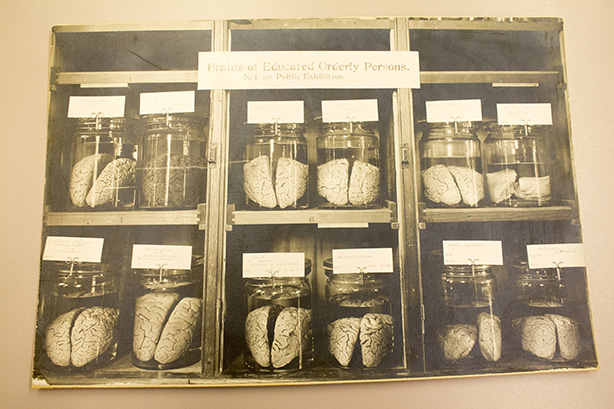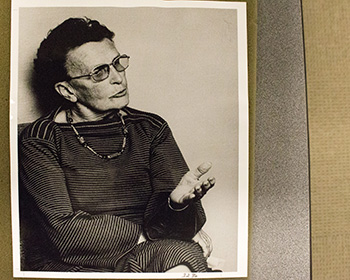From The Collections
Faculty papers illuminate research, add context to archives

A photograph from the archive of natural history professor Burt Green Wilder, Cornell's first animal biologist, who created what's now called the Wilder Brain Collection, kept today in Uris Hall.
Faculty papers tell the story of Cornell.
Hundreds of sets of faculty papers, stretching back to Cornell's beginnings, comprise a hefty component of the University Archives, in Cornell University Library's Division of Rare and Manuscript Collections. Their contents are incredibly diverse and include lecture notes, international awards, correspondence with world leaders and photos of specimens or samples.

Biochemistry professor James B. Sumner's Nobel Prize in chemistry (1946). See larger image
These collections illuminate the teaching methods that shaped generations of Cornellians and the faculty research that changed the world.
They provide context to scientific discoveries, such as Hans Bethe's Nobel Prize-winning research in astrophysics, quantum electrodynamics and solid-state physics.
They fill in valuable behind-the-scenes details of trailblazing scholarship, from women's studies to agriculture to engineering.

ILR professor Alice H. Cook, whose papers are housed at the Kheel Center for Labor-Management Documentation and Archives. See larger image
"State-of-the-art research has been happening at Cornell since its earliest days, and we want to make sure we capture that," says Evan Earle '02, M.S. '14, the Dr. Peter J. Thaler '56 University Archivist. "It's also very important to look back and see what was taught and how it was taught – both can be equally fascinating."
The faculty papers are complemented by other collections, too. Just as faculty papers can shed light on the student experience, student papers can preserve information about their professors that might otherwise be lost. For instance, student notebooks reveal that Vladimir Nabokov's 1950s Literature 311 class was nicknamed "Dirty Lit," and that Nabokov told them – perhaps in jest – that they'd need "medical evidence" if they wanted to "repair to the bathroom" during the final exam.

Some of Wilder's bone specimens. See larger image
Today, Cornell's archivists work not just to preserve and make accessible records of the past, but to capture the present Cornell experience. Twenty-first century archivists grapple with the increasingly digital nature of personal collections. Websites and social media posts have become essential elements to understanding a researcher's work and impact, but preserving them – amid constantly changing technology – represents new challenges. To that end, the library recently hired its first-ever born-digital archivist, who focuses daily on preserving items that were "born" digital – items that never existed in physical form.
But whatever format future collections take, faculty are encouraged to contact the Archives about organizing and preserving their materials – both the physical and the virtual – so the output of today's influential thinkers, and tomorrow's Nobel Prize winners, remains available for history and research.
Questions about faculty papers? Contact Evan Earle, efe4@cornell.edu.